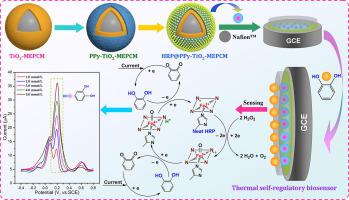Chemical Engineering Journal ( IF 15.1 ) Pub Date : 2021-10-16 , DOI: 10.1016/j.cej.2021.132982 Jian Xiong 1 , Zhao Sun 1 , Jinghua Yu 1 , Huan Liu 1 , Xiaodong Wang 1

|
Conventional enzyme-based biosensors are highly sensitive to operation temperature due to a strong temperature dependency of biocatalytic activity. Aiming to enhance the biosensing detection of hazardous substances at high ambient temperatures, we focused on the design and construction of a thermal self-regulatory smart biosensor through an innovative combination of phase change material (PCM) and bioelectrocatalytic material. A bioelectrocatalytic phase-change microcapsule system was first fabricated by microencapsulating n-eicosane as a PCM core in the TiO2 shell and then depositing polypyrrole (PPy) as an electroactive coating layer on the surface of TiO2 shell, followed by immobilizing horseradish peroxidase on the surface of PPy coating layer through physical adsorption. The resultant microcapsules exhibit a regular spherical morphology and layer-by-layer core–shell microstructure with the desired chemical compositions. The microcapsules not only exhibit a good thermal management ability to perform effective temperature regulation under a latent-heat capacity of approximately 115 J/g, but also reveal high thermal impact resistance and good thermal cycle stability for the long-term thermal management application in biosensors. A working electrode was modified with the microcapsules obtained above and then used to construct an electrochemical biosensing system imparted with a thermal self-regulation capability. With a high sensitivity of 5.571 µA·L·µmol−1·cm−2 and a low detection limit of 5.384 µmol/L at 55 °C, the resultant smart biosensor exhibits a better determination ability to detect catechol as a model hazardous substance at high operation temperatures than conventional biosensors thanks to the in-situ thermal management derived from its n-eicosane core. This study provides a new approach for development of thermal self-regulatory smart biosensors with an enhanced identification capability to detect hazardous substances over a wide range of temperatures.
中文翻译:

基于辣根过氧化物酶固定相变微胶囊的热自调控智能生物传感器增强有害物质检测
由于生物催化活性的强烈温度依赖性,传统的基于酶的生物传感器对操作温度高度敏感。为了增强高环境温度下有害物质的生物传感检测,我们专注于通过相变材料(PCM)和生物电催化材料的创新组合设计和构建热自调节智能生物传感器。甲生物电相变微胶囊系统首先通过微胶囊化而制作Ñ -eicosane如在TiO一个PCM芯2 TiO 2的表面上的壳,然后沉积聚吡咯(PPY)作为电被覆层2壳,然后通过物理吸附将辣根过氧化物酶固定在PPy涂层表面。所得微胶囊具有规则的球形形态和具有所需化学成分的逐层核壳微观结构。该微胶囊不仅表现出良好的热管理能力,可在约 115 J/g 的潜热容量下进行有效的温度调节,而且还表现出高抗热冲击性和良好的热循环稳定性,可用于生物传感器的长期热管理应用. 用上述获得的微胶囊修饰工作电极,然后用于构建具有热自调节能力的电化学生物传感系统。具有 5.571 µA·L·µmol -1 ·cm的高灵敏度−2和 55 °C 下 5.384 µmol/L 的低检测限,由于衍生的原位热管理,所得到的智能生物传感器在高操作温度下表现出比传统生物传感器更好的检测邻苯二酚作为模型有害物质的能力从它的n -二十烷核心。该研究为开发具有增强识别能力的热自调节智能生物传感器提供了一种新方法,可在较宽的温度范围内检测有害物质。


























 京公网安备 11010802027423号
京公网安备 11010802027423号